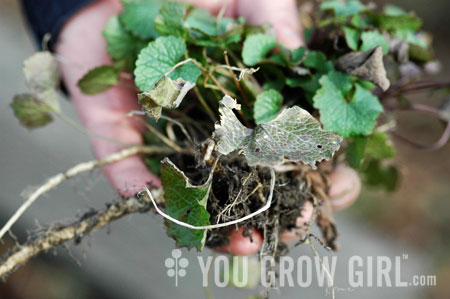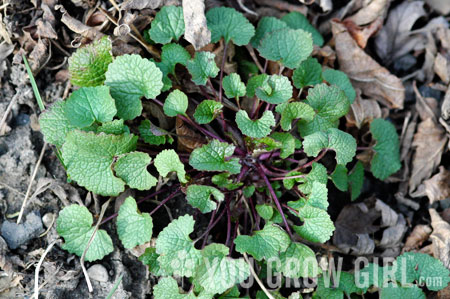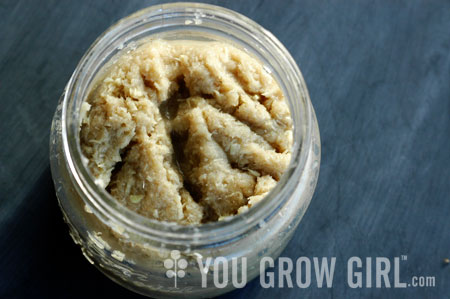
Another spring and a new crop of garlic mustard (Alliaria petiolata) is setting up camp for the season. We found a few small plants in the street garden cleanup last week and several at the community garden, many that were already much larger and lusher than any of the other cold hardy perennials growing there. And all of that despite the fact that this is my third year diligently removing every plant I find!
Now is the time to remove this highly invasive plant while it is still small and easy to pull. We learned the hard way last year that by May the roots are already enormous and deeply set. I took the above photo of an entire plant just a few days ago and the roots were already substantial.

Here’s what the plant looks like right now. In the early stages it looks more like a common violet, but the distinctive garlic smell is unmistakable. Here are some photos of later stage plants for identification.
When removing the plant, be sure to pull up as much of the root system as possible. Pull when the soil is moist and loose and use a weeding tool if you have to. Destroy the plant, roots and all — do not put it into the compost bin! Or better yet, eat it. As I’ve mentioned before, that distinctive garlicy smell and flavor lends itself to all kinds of uses.
Free food!

A jar of garlic mustard root “horseradish” that we made last spring.
My favorite way to eat it is lightly sautéed with some butter; however, we have tried making it into pesto by simply whizzing the leaves up in a food processor with a splash of olive oil and salt, and grating the roots into a horseradish substitute. The pesto is a bit bitter raw, I prefer it cooked. I’m thinking of using this year’s harvest to make “garlicy” mashed potatoes. The fake horseradish was okay, but since it took us several hours work washing and grating thin roots, I wouldn’t recommend it.
Looks like I’ve got a bit of that, though it’s only one plant so far. Will definitely pull & destroy ASAP.
Wow – that is quite a root system for a plant that is only a couple days old.
Melanie: I took the photo a few days ago. Garlic mustard is extremely cold hardy; the plant itself is much older than a few days.
Where does this plant commonly grow? I’ve never seen in around here (Northern California, zone 9) which from what you’ve said, is a good thing. But I’d sure like to try that horseradish!
Do you have Japanese knotweed? Here’s a crumble recipe via Franklin Park Coalition: http://www.franklinparkcoalition.org/knotweed-recipe.
So that’s what it is! I’m new to gardening and don’t know anything. Noticed these little ‘plants’ the other day and wondered what they were. Thanks! :)
It does look a lot like a violet! I have what I thought were violets in my yard, but I will definitely be keeping a closer eye on then now. Thank you for the info Gayla
It also makes a nice addition to homemade salsa :) I have also thrown it in salads as well (as an extra “accent” green).
I have always wondered what it would be like dried (and used as a “spice”).
Is that what that is?? I always thought it was called “creeping Charlie”… It is a huge pain in the ass, but if I can eat it that’s a whole nother story!
I’m just learning you can eat this. I’ve been pulling it for several years on the land I care for, too. And you’re right: it’s just about the only green thing in the woods–except for the bush honeysuckles leafing out.
Gayla… like Yvette I too thought this was creeping charlie from the photo. Do you know if they start out looking the same?
Yvette and Jen: Garlic mustard is distinctly different than Creeping Charlie aka Ground Ivy (Glechoma hederacea).
Garlic mustard plants grow in rosettes; ground ivy is a low-growing creeper. Mustard garlic leaves are at least a few inches in size, while ground ivy leaves are tiny. The plant eventually bolts into a tall tower with white flowers… ground ivy remains a creeping, low-growing plant.
Funny you post this now- I have a post scheduled to pop up on SV today on the same topic, which links back to your post from last year! Good gardeners think alike eh?
i pulled some of this the other day and enjoyed the garlicky fragrance. good to know you can eat it, too.
this stuff is not a problem around my place. we’re inundated by bishop’s weed. if you have any advice about that, let me know!
Funny, we have a weed in Australia we also call Creeping Charlie but it’s a different plant all together (Plectranthus verticillatus). The wonders of common names…
ooh is that what it is? cool! and it’s edible! even better…
I love finding edible wildgrowing things… Last year I discovered lambs quarters, this year it’s garlic mustard… isn’t the wild world wonderful?
I used to live in Cincinnati and this stuff grew all over my neighborhood. It made me crazy. I’d spend an afternoon pulling an area and days later it would be covered again. Just looking at the photo brings the smell back to mind! I hated it too much to eat, although I’m sure it’s delicious.
I’ve noticed some of this around my yard. Good timing too, with the rain we’re scheduled to get today it should make it easier to pull these out. Me and my yard thank you! Now I’m off to look for some recipes!
Thanks for the heads-up. The USDA classifies this pest as an invasive species and has an excellent website that I’ve used quite a bit:
http://www.invasivespeciesinfo.gov/plants/garlicmustard.shtml
Oh! Cool. I have something like this in the garden but I thought they were violets, we also have a smattering of those but the leaves on these things are a bit different, growing much larger than violets. However, I’ve never seen these things flower. At least I don’t remember seeing it! Is the garlicky smell obvious or is it only present if the leaves or roots are crushed and processed somehow?
We have that! Someone even told me that it’s wild mustard, but it stupidly didn’t occur to me to eat it, and I’m actually the type who will eat particularly yummy looking dandelion leaves, purslane, and wild onions from the yard. Will be on the hunt for it tomorrow. Looking forward to trying it.
Hrm. After seeing your pics and looking up more info online, I’m still not sure that what I have is Garlic Mustard. There is no garlicky smell at all (just in case my nose is shutting down on me I’ve had other people smell it. ;) If there is a plant out there that looks like this but is not this then I won’t be eating it anytime soon. I just wish i knew what on earth it is as it’s everywhere! Anyways, awesome site!
I wish I enjoyed eating garlic mustard, but I think it is disgusting. It is widespread around northern Jersey. =( It is particularly odious because it makes a chemical that kills off the friendly fungi that help other plants’ roots. (Mustards do not associate with fungi to help them gain water and nutrients like most other plants do.) The garlicky smell is released when you break and crush any piece of the plant, so try that if you aren’t sure about ID. Thank you for getting the anti-garlic mustard message out Gayla!!!
I’m not sure I could bring myself to eat the stuff. In my rural zone 5 garden, garlic mustard is EVERYWHERE. Turn your back for one day and it has overtaken another bed. It’s biennial so it’s particularly tricky to irradicate (at this point I’m aiming to just control it). I’d say I fill up about 15-20 drum liners a spring with it, and that’s just from my small property. What a menace.
o this stuff is such a PITA.
i have had it in my hedges for the past 5 years…
I read somewhere the seeds can live, active, in the soil for like 7 years…
thankfully, where it is growing in my yard, it is easy to pull and the root system seems shallow…
I hate it too much to eat it tho…lol..nasty little buggers…
I spent last Saturday plucking that weed with my church for community service! We collected maybe 30 trash bags of them!!!